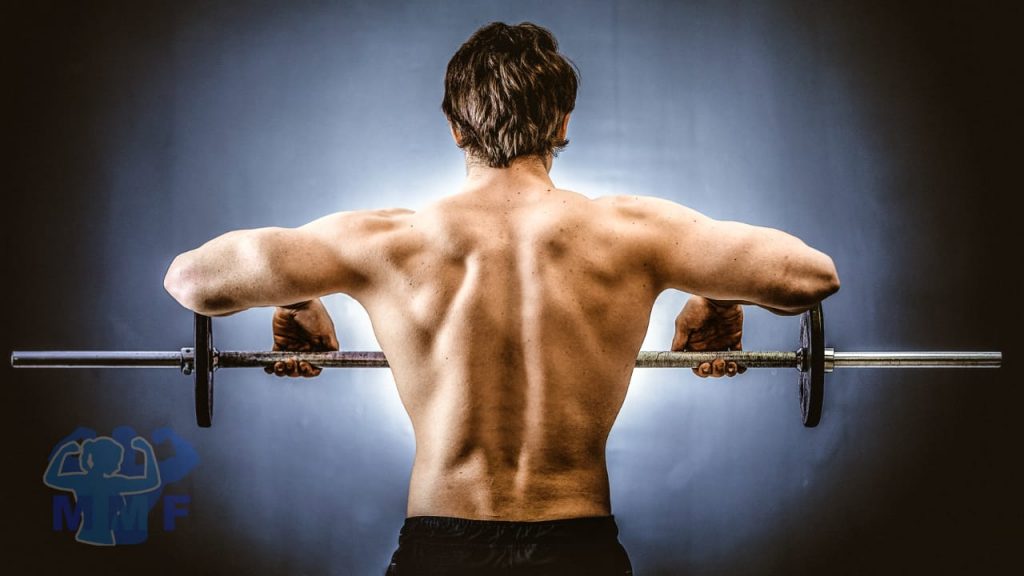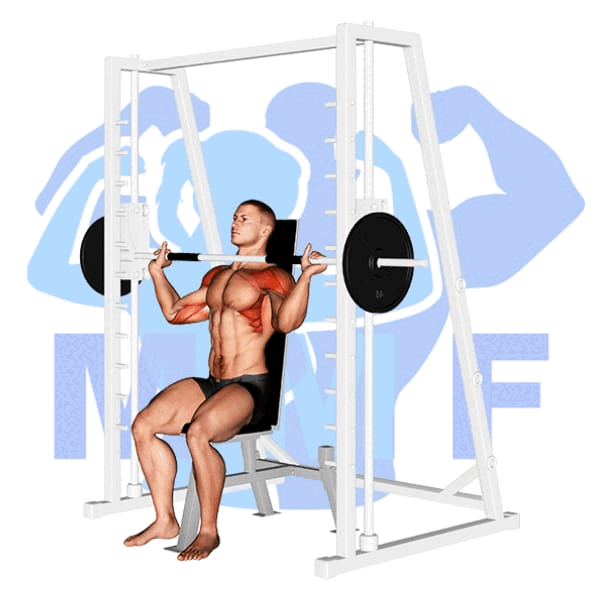The Upright Barbell Row is an exercise for the development of the shoulders and trapezius muscles. It is fundamental a weight lifting shoulder exercise performed while standing, holding a weight hanging down in the hands and lifting it straight up to the collarbone.
Barbell Upright Row Overview
- Primary Muscle(s) Worked: Deltoid, lateral (shoulder), upper trapezius
- Other Muscles Worked: See below
- Equipment: Barbell
- Mechanics Type: Compound (An exercise that involves two or more joint movements)
- Force: Pull (Their compound counterparts classify a movement toward the center of the body during the concentric contraction of the target muscle. Isolated movements).
- Utility: Basic (A regular exercise that can place higher absolute intensity on muscles exercised relative to auxiliary lifts. Basic exercises tend to be gravity-dependent, and they have inclusion or shift in resistance through multiple muscle group. Throughout the range of motion the muscles that are engaged will change (e.g., bench press: front deltoid to pectoralis major to triceps). These exercises have a natural transfer of torsion force to compression force (e.g., lockout on squats, bench press, etc.) or tension force (e.g., the extension of arm curl) to the bone(s) and joint(s) during full range of motion).
Muscles Worked in Barbell Upright Row
- Deltoids, lateral
- Upper back
Synergist Muscles Worked When Performing the Barbell Upright Row
- Deltoid, Anterior
- Supraspinatus
- Trapezius, Middle
- Trapezius, Lower
- Brachialis
- Brachioradialis
- Biceps Brachii
- Serratus Anterior
- Inferior Digitations
- Teres Minor
- Infraspinatus
- Teres Minor
Stabilizers Worked When Performing the Barbell Upright Row
- Trapezius, Upper
- Levator Scapulae
- Biceps Brachii
- Triceps, Long Head
How to Properly Perform the Barbell Upright Row
- Grasp bar with shoulder width or slightly narrower overhand grip.
- While inhaling, pull the bar to the chin with elbows leading. Keep the elbows jutting up and out while maintaining physical proximity to the weights. Allow wrists to flex as you raise the bar.
- At the top position, make sure the elbows are higher than the wrists and the shoulders.
- While keeping, the torso and knees in the same position, exhale, slowly returning the barbell to the starting position.
- Repeat.
Caution Needed when Performing the Upright Barbell Row
Even with the great benefits of the upright row, the barbell upright row can be one of the most harmful shoulder exercises. If you don’t position your arms properly. You can cause serious damage to your shoulders and tendons.
How to Prevent Injury During Upright Rows
Your arms are bent at the elbow then internally rotated, to execute the upright row properly. The problem arises in the internal rotation when you raise the arms and add resistance in that position. Every time you lift the weight, impingement occurs at a small tendon in your shoulder. Because upright rows place the shoulder joint in full internal rotation as you raise your arm, this position does not allow sufficient space for the greater tubercle of the humerus to clear the acromion. Not having sufficient space causes an impingement syndrome in the A/C joint and can lead to chronic tendinitis or bursitis.
How to Avoid Rotator Cuff Problems
The upright row can also a significant contributor to rotator cuff problems. Rotator cuff injuries are straightforward to acquire, and often require surgery and months of rehab to recover from. Even if the upright row is performed with proper execution, upright rows can lead to long-term shoulder pain and injury. Be smart and avoid this exercise. There are plenty of other movements which deliver success without such risk.
Tips for Performing Barbell Upright Rows
- Do not use too narrow a grip. You will decrease the subacromial space (the area between the greater tubercle of the humerus and acromioclavicular joint) which may potentially impinge the supraspinatus tendon and the subacromial bursa (a protective sac of fluid cushioning the bone from the tendon). A wider grip allows for more space between the shoulder joint and the head of the humerus allowing for more clearance of the underlying structures.
- Do not over rotate the arms. When you over turn your arms, you risk an injury.
- Use proper weight. Ensure that you can handle the weight so as not to overstress the shoulder.
Common Errors While Performing the Barbell Upright Row
- Leaning back too far. A common mistake many novice lifters make is leaning back as you pull the bar up.
- Grip too wide. Keep the bar shoulder width apart to work the entire trap and deltoid. Using too wide of a grip prevents your trapezius from assisting in the movement.
- Grip too narrow. Keep the bar shoulder width apart to work the entire trap and deltoid. Using too narrow of a grip can result in impingement at the shoulder joint
- Jerking the weight up. Do not jerk the weight. Not only can this cause you to lose proper form and lead to injury but it also takes the resistance off the muscle and will diminish the exercise effectiveness.
- Performing the movement too fast. Performing the action too fast doesn’t allow you to recruit as many muscle fibers fully.
Variations of the Barbell Upright Row
These variations are intended to work different subgroups of muscles or work the same muscles in slightly different ways. There are plenty of varying row exercises. Some other similar lifts to the barbell upright row include:
- Dumbbell Upright Row. Same movements as detailed above.
- Cable Row. The advantage of a cable upright row is the continual tension during the exercise from the cable upright row.
- Upright Row using the Smith Machine. Same movements as detailed above.
Additional Exercises to Compliment the Upright Row
- Front Lateral Raises with Dumbbells or Barbell – are an excellent exercise for the anterior deltoids (front shoulders).
- Dumbbell Side Lateral Raises – are an excellent exercise for the medial deltoids (shoulders)
- Dumbbell or Barbell Shrugs – works the Trapezius and also engages many other muscles in the back (Erector Spinae, Rhomboids, Teres Major, Teres Minor, Rear Deltoid, Posterior, etc.).



